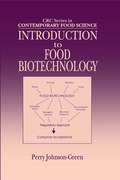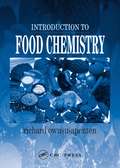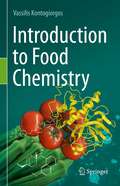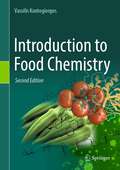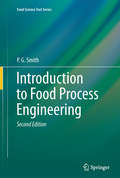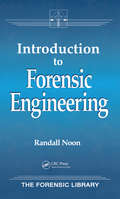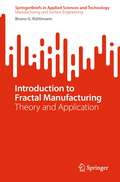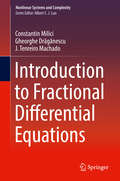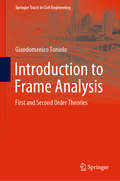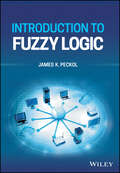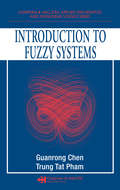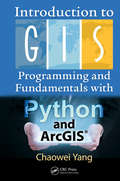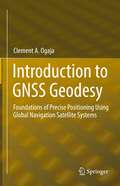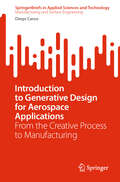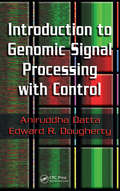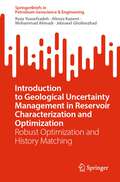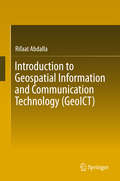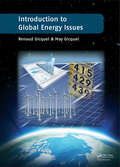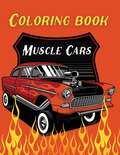- Table View
- List View
Introduction to Food Biotechnology (Contemporary Food Science)
by Perry Johnson-GreenUniversities throughout the US and the rest of the world offer Food Biotechnology courses. However, until now, professors lacked a single, comprehensive text to present to their students. Introduction to Food Biotechnology describes, explains, and discusses biotechnology within the context of human nutrition, food production, and food processing. Written for undergraduate students in Food Science and Nutrition who do not have a background in molecular biology, it provides clear explanations of the broad range of topics that comprise the field of food biotechnology. Students will gain an understanding of the methods and rationales behind the genetic modification of plants and animals, as well as an appreciation of the associated risks to the environment and to public health. Introduction to Food Biotechnology examines cell culture, transgenic organisms, regulatory policy, safety issues, and consumer concerns. It covers microbial biotechnology in depth, emphasizing applications to the food industry and methods of large-scale cultivation of microbes and other cells. It also explores the potential of biotechnology to affect food security, risks, and other ethical problems.Biotechnology can be used as a tool within many disciplines, including food science, nutrition, dietetics, and agriculture. Using numerous examples, Introduction to Food Biotechnology lays a solid foundation in all areas of food biotechnology and provides a comprehensive review of the biological and chemical concepts that are important in each discipline. The book develops an understanding of the potential contributions of food biotechnology to the food industry, and towards improved food safety and public health.
Introduction to Food Chemistry
by Richard Owusu-ApentenProviding a thorough introduction to the core areas of food science specified by the Institute of Food Technologists, Introduction to Food Chemistry focuses on principles rather than commodities and balances facts with explanations. The text covers the major areas of food science, including food chemistry, food analysis and methods for quality assu
Introduction to Food Chemistry
by Vassilis KontogiorgosThe complexity of food chemistry makes it a challenging subject for students studying in a food science course. Although there are excellent food chemistry books available in the market they have two major flaws: they are either encyclopedic or they are not pitched correctly to undergraduate food science students. The first problem creates difficulties for students to identify what is important and how much they need to know. The second problem arises when the book is written by authors that are not food scientists (e.g., chemists), they are not academics that are engaged with teaching or they are not sufficiently qualified to teach. In this case, it is difficult to find links between the chemistry of foods and its relevance to applications or, quite frequently, future employment prospects of the student. Introduction to Food Chemistry bridges this gap in the relevant literature, as it employs the latest pedagogical theories in textbook writing to present the subject to students with broad range of cognitive skills. This book presents specific learning objectives for each chapter and is self-contained so students will not need to search for essential information outside the textbook. To support learning, the book has:Didactic elements with information being conveyed with 3D-figures, color-coded schemes and graphs, annotations on figures that link it to the text descriptionsBuilt-in pedagogy and learning activities at the end of each chapter that are linked to the learning objectives.Keywords and concepts for online search to instigate curiosity for further studies.Conversational writing style without losing academic rigorTo support lecturers, the book has:Helps focus teaching preparation on key aspects of food chemistry relevant to both industry and modern research.Aids the preparation of exams, assignments and other types of assessment or learning activities.For lecturers in search of a singular source to aid in their introductory food chemistry courses, look no further than Introduction to Food Chemistry.
Introduction to Food Chemistry
by Vassilis KontogiorgosThe complexity of food chemistry makes it a challenging subject for students studying in a food science course. Although there are excellent food chemistry books available in the market they have two major flaws: they are either encyclopedic or they are not pitched correctly to undergraduate food science students. The first problem creates difficulties for students to identify what is important and how much they need to know. The second problem arises when the book is written by authors that are not food scientists (e.g., chemists), they are not academics that are engaged with teaching or they are not sufficiently qualified to teach. In this case, it is difficult to find links between the chemistry of foods and its relevance to applications or, quite frequently, future employment prospects of the student. Introduction to Food Chemistry, 2nd Edition bridges this gap in the relevant literature, as it employs the latest pedagogical theories in textbook writing to present the subject to students with broad range of cognitive skills. This book presents specific learning objectives for each chapter and is self-contained so students will not need to search for essential information outside the textbook. This new edition has been expanded to include chapters on sweeteners, glass transition, amino acids, proteins for major food commodities and food additives. All of the original chapters have been updated and expanded to include new research and technologies. To support learning, the book has:Didactic elements with information being conveyed with 3D-figures, color-coded schemes and graphs, annotations on figures that link it to the text descriptionsBuilt-in pedagogy and learning activities at the end of each chapter that are linked to the learning objectives.Keywords and concepts for online search to instigate curiosity for further studies.Conversational writing style without losing academic rigorTo support lecturers, the book has:Helps focus teaching preparation on key aspects of food chemistry relevant to both industry and modern research.Aids the preparation of exams, assignments and other types of assessment or learning activities.For lecturers in search of a singular source to aid in their introductory food chemistry courses, look no further than this expanded new edition of Introduction to Food Chemistry.
Introduction to Food Process Engineering
by P. G. SmithThis is a new book on food process engineering which treats the principles of processing in a scientifically rigorous yet concise manner, and which can be used as a lead in to more specialized texts for higher study. It is equally relevant to those in the food industry who desire a greater understanding of the principles of the food processes with which they work. This text is written from a quantitative and mathematical perspective and is not simply a descriptive treatment of food processing. The aim is to give readers the confidence to use mathematical and quantitative analyses of food processes and most importantly there are a large number of worked examples and problems with solutions. The mathematics necessary to read this book is limited to elementary differential and integral calculus and the simplest kind of differential equation.
Introduction to Food Process Engineering (Food Preservation Technology)
by Albert Ibarz Gustavo V. Barbosa-CanovasConsumer expectations are systematically growing, with demands for foods with a number of attributes, which are sometimes difficult for manufacturers to meet. The engineering processes that are needed to obtain top-quality foods are a major challenge due to the diversity of raw materials, intermediates, and final products. As in any other enterpris
Introduction to Forensic Engineering (Forensics Library)
by Randall K. NoonForensic engineering is generally defined as the application of engineering principles and methodology to answer questions of fact that may have legal ramifications. This new book provides an introduction to the science, methodology, and engineering principles involved in the diagnosis of some common types of accidents and failures, such as fires, explosions, automobile accidents, storm damage, industrial accidents, slips and falls, arson, water pipe damage and more. Each chapter stands alone and can be read without reference to the others. The chapters have been written so that non-technical professionals can easily digest the information and immediately apply it. The book will also be useful to technical professionals who are unfamiliar with particular investigative methodology or technical points of interest. Introduction to Forensic Engineering will benefit lawyers, insurance investigators, engineers, and other professionals who must handle investigative and legal aspects of accidents or failures.
Introduction to Fractal Manufacturing: Theory and Application (SpringerBriefs in Applied Sciences and Technology)
by Bruno G. RüttimannThis book offers a comprehensive exploration of a new manufacturing mode designed to revolutionize the reliability of interdependent networks. It provides the necessary theoretical foundation and practical implementation guidance for Fractal Manufacturing with Variable Quantum Flow, an innovative manufacturing approach tailored to reduce process lead time (PLT) and to meet the demands of value chains reliant on 100% on-time delivery (OTD). The book introduces readers to introductory concepts, delves into the evolution from the BCT Deviation Function to Fractal Manufacturing, characterizes the Fractal Manufacturing system, and explores additional aspects beyond its modeling. With a focus on non-deterministic business environments and make-to-order productions, this book presents a pushed JIT system that is poised to transform manufacturing practices
Introduction to Fractional Differential Equations (Nonlinear Systems And Complexity Ser. #25)
by Constantin Milici Gheorghe Drăgănescu J. Tenreiro MachadoThis book introduces a series of problems and methods insufficiently discussed in the field of Fractional Calculus – a major, emerging tool relevant to all areas of scientific inquiry. The authors present examples based on symbolic computation, written in Maple and Mathematica, and address both mathematical and computational areas in the context of mathematical modeling and the generalization of classical integer-order methods. Distinct from most books, the present volume fills the gap between mathematics and computer fields, and the transition from integer- to fractional-order methods.
Introduction to Frame Analysis: First and Second Order Theories (Springer Tracts in Civil Engineering)
by Giandomenico TonioloThis textbook presents the principal methods of stress analysis for the design of frame structures, beginning with a description of the basic criteria for probabilistic safety verification used in modern codes. The Force Method and the Displacement Method are dealt with, together with their applications to more common structural situations. A special chapter is dedicated to the second order analysis required for slender structures and for the elaboration of instability problems. In turn, a thorough set of numerical examples rounds out the text. Given its scope, the book offers an ideal learning resource for students of Civil and Building Engineering and Architecture, and a valuable reference guide for practicing structural design professionals.
Introduction to Fuel Cells: Electrochemistry and Materials
by San Ping Jiang Qingfeng LiThis textbook covers essential electrochemistry and materials science content and provides an extensive collection of examples in order to bridge the gap between engineering students’ basic knowledge and the concrete skills they need to handle practical problems in fuel cells. The book starts with an introduction to the basic thermodynamics and electrochemistry principles and techniques in fuel cells. It subsequently discusses fuel cell operation principles, electrocatalysts, electrode materials, cell and system configuration and technologies in low-temperature fuel cells such as alkaline fuel cells and proton exchange membrane fuel cells, and in high-temperature fuel cells including solid oxide and molten carbonate fuel cells. Other energy conversion and storage technologies such as supercapacitors, batteries and electrolysis are also covered. A special chapter on laboratory experiments with fuel cells is also included, which can be conducted in conjunction with classroom teaching. Each chapter includes problems and exercises.The book provides students with an engineering background essential information on the basic thermodynamics, electrochemistry and materials of fuel cells, the most efficient and environmentally friend energy conversion technologies, all in a single book.
Introduction to Functional Nanomaterials
by Fabian I. Ezema M. AnusuyaThis book provides a comprehensive review of nanomaterials, including essential foundational examples of nanosensors, smart nanomaterials, nanopolymers, and nanotubes. Chapters cover their synthesis and characteristics, production methods, and applications, with specific sections exploring nanoelectronics and electro-optic nanotechnology, nanostructures, and nanodevices. This book is a valuable resource for interdisciplinary researchers who want to learn more about the synthesis of nanomaterials and how they are used in different types of energy storage devices, including supercapacitors, batteries, fuel cells solar cells in addition to electrical, chemical, and biomedical engineering.Key Features: Comprehensive overview of how nanomaterials can be utilised in a variety of interdisciplinary applications Explores the fundamental theories, alongside their electrochemical mechanisms and computation Discusses recent developments in electrode designing based on nanomaterials, separators, and the fabrication of advanced devices and their performances
Introduction to Fuzzy Logic
by James K. PeckolINTRODUCTION TO FUZZY LOGIC Learn more about the history, foundations, and applications of fuzzy logic in this comprehensive resource by an academic leader Introduction to Fuzzy Logic delivers a high-level but accessible introduction to the rapidly growing and evolving field of fuzzy logic and its applications. Distinguished engineer, academic, and author James K. Peckol covers a wide variety of practical topics, including the differences between crisp and fuzzy logic, the people and professionals who find fuzzy logic useful, and the advantages of using fuzzy logic. While the book assumes a solid foundation in embedded systems, including basic logic design, and C/C++ programming, it is written in a practical and easy-to-read style that engages the reader and assists in learning and retention. The author includes introductions of threshold and perceptron logic to further enhance the applicability of the material contained within. After introducing readers to the topic with a brief description of the history and development of the field, Introduction to Fuzzy Logic goes on to discuss a wide variety of foundational and advanced topics, like: A review of Boolean algebra, including logic minimization with algebraic means and Karnaugh maps A discussion of crisp sets, including classic set membership, set theory and operations, and basic classical crisp set properties A discussion of fuzzy sets, including the foundations of fuzzy set logic, set membership functions, and fuzzy set properties An analysis of fuzzy inference and approximate reasoning, along with the concepts of containment and entailment and relations between fuzzy subsets Perfect for mid-level and upper-level undergraduate and graduate students in electrical, mechanical, and computer engineering courses, Introduction to Fuzzy Logic covers topics included in many artificial intelligence, computational intelligence, and soft computing courses. Math students and professionals in a wide variety of fields will also significantly benefit from the material covered in this book.
Introduction to Fuzzy Systems (Chapman & Hall/CRC Applied Mathematics & Nonlinear Science)
by Guanrong Chen Trung Tat PhamIntroduction to Fuzzy Systems provides students with a self-contained introduction that requires no preliminary knowledge of fuzzy mathematics and fuzzy control systems theory. Simplified and readily accessible, it encourages both classroom and self-directed learners to build a solid foundation in fuzzy systems. To keep pace with and further advance the rapidly developing field of applied control technologies, this book provides systematic training in the analytic theory and rigorous design of fuzzy systems. Almost entirely self-contained, it establishes a brief, yet sufficient foundation for designing and analyzing fuzzy intelligent and control systems. It clearly explains fuzzy sets, fuzzy logic, fuzzy inference, approximate reasoning, fuzzy rule base, basic fuzzy PID control systems, and more. This outstanding text includes teaching examples as well as problem exercises, and it can easily be used as a classroom text or tutorial for self-study that will prepare readers for further work in the field.
Introduction to GIS Programming and Fundamentals with Python and ArcGIS®
by Chaowei YangCombining GIS concepts and fundamental spatial thinking methodology with real programming examples, this book introduces popular Python-based tools and their application to solving real-world problems. It elucidates the programming constructs of Python with its high-level toolkits and demonstrates its integration with ArcGIS Theory. Filled with hands-on computer exercises in a logical learning workflow this book promotes increased interactivity between instructors and students while also benefiting professionals in the field with vital knowledge to sharpen their programming skills. Readers receive expert guidance on modules, package management, and handling shapefile formats needed to build their own mini-GIS. Comprehensive and engaging commentary, robust contents, accompanying datasets, and classroom-tested exercises are all housed here to permit users to become competitive in the GIS/IT job market and industry.
Introduction to GNSS Geodesy: Foundations of Precise Positioning Using Global Navigation Satellite Systems
by Clement A. OgajaIntroduction to GNSS Geodesy is a concise reference for beginners and experts in GNSS-based satellite geodesy. It covers all of the important concepts in almost a third of the space of the other GNSS books. Th e book begins with a case study in Augmented Reality to set the stage for what is to come and then moves on to the key elements of GNSS geodesy that make accurate and precise geopositioning possible. For example, it is important to understand the geodetic reference systems and the associated GNSS data processing strategies that enable both accurate and high-precision geopositioning. Chapter 2 gives an overview of GNSS constellations and signals, highlighting important characteristics. Chapter 3 then introduces reference systems in geodesy, covering such topics as time systems, geodetic datums, coordinate systems, coordinate conversions and transformations, and International Terrestrial Reference Frame. Th is lays the framework for the rest of the book. Chapters 4 and 5 dig deep into mathematical formulation of GNSS parameter estimation and observation models. All the concepts are presented clearly and concisely, with diagrams to assist reader comprehension. Chapter 6 describes Continuously Operating Reference Station (CORS) networks and their role in geodesy and definition of reference frames. Various global and regional CORS networks are presented in this section. Th e chapter also covers GNSS data and common formats such as RINEX and RTCM. Chapter 7 introduces the whole cycle of GNSS data processing, including preprocessing, ambiguity fixing, and solution reprocessing methods as commonly used in both epoch solutions and time series data. Th e book concludes with appendices on orbit modelling, GNSS linear combinations, application examples, and an example linear model.
Introduction to Generative Design for Aerospace Applications: From the Creative Process to Manufacturing (SpringerBriefs in Applied Sciences and Technology)
by Diego CarouThis book provides a comprehensive introduction to generative design in the aerospace sector, guiding readers from initial creative concepts to the final stages of manufacturing. It offers a thorough exploration of sustainable production methods, cutting-edge technological advancements, and the principles of generative design. With a focus on artificial intelligence's role in optimizing design and manufacturing, this book also delves into topology optimization, offering valuable insights for both newcomers and experienced professionals in the field. Through practical examples and a structured approach, readers will gain a solid understanding of the innovations shaping the future of aerospace design.
Introduction to Genomic Signal Processing with Control
by Edward R. Dougherty Aniruddha DattaStudying large sets of genes and their collective function requires tools that can easily handle huge amounts of information. Recent research indicates that engineering approaches for prediction, signal processing, and control are well suited for studying multivariate interactions. A tutorial guide to the current engineering research in genomics, Introduction to Genomic Signal Processing with Control provides a state-of-the-art account of the use of control theory to obtain intervention strategies for gene regulatory networks. The book builds up the necessary molecular biology background with a basic review of organic chemistry and an introduction of DNA, RNA, and proteins, followed by a description of the processes of transcription and translation and the genetic code that is used to carry out the latter. It discusses control of gene expression, introduces genetic engineering tools such as microarrays and PCR, and covers cell cycle control and tissue renewal in multi-cellular organisms.The authors then delineate how the engineering approaches of classification and clustering are appropriate for carrying out gene-based disease classification. This leads naturally to expression prediction, which in turn leads to genetic regulatory networks. The book concludes with a discussion of control approaches that can be used to alter the behavior of such networks in the hope that this alteration will move the network from a diseased state to a disease-free state.Written by recognized leaders in this emerging field, the book provides the exact amount of molecular biology required to understand the engineering applications. It is a self-contained resource that spans the diverse disciplines of molecular biology and electrical engineering.
Introduction to Geological Uncertainty Management in Reservoir Characterization and Optimization: Robust Optimization and History Matching (SpringerBriefs in Petroleum Geoscience & Engineering)
by Jebraeel Gholinezhad Reza Yousefzadeh Alireza Kazemi Mohammad AhmadiThis book explores methods for managing uncertainty in reservoir characterization and optimization. It covers the fundamentals, challenges, and solutions to tackle the challenges made by geological uncertainty. The first chapter discusses types and sources of uncertainty and the challenges in different phases of reservoir management, along with general methods to manage it. The second chapter focuses on geological uncertainty, explaining its impact on field development and methods to handle it using prior information, seismic and petrophysical data, and geological parametrization. The third chapter deals with reducing geological uncertainty through history matching and the various methods used, including closed-loop management, ensemble assimilation, and stochastic optimization. The fourth chapter presents dimensionality reduction methods to tackle high-dimensional geological realizations. The fifth chapter covers field development optimization using robust optimization, including solutions for its challenges such as high computational cost and risk attitudes. The final chapter introduces different types of proxy models in history matching and robust optimization, discussing their pros and cons, and applications. The book will be of interest to researchers and professors, geologists and professionals in oil and gas production and exploration.
Introduction to Geometric Control (Springer Optimization and Its Applications #192)
by Yuri SachkovThis text is an enhanced, English version of the Russian edition, published in early 2021 and is appropriate for an introductory course in geometric control theory. The concise presentation provides an accessible treatment of the subject for advanced undergraduate and graduate students in theoretical and applied mathematics, as well as to experts in classic control theory for whom geometric methods may be introduced. Theory is accompanied by characteristic examples such as stopping a train, motion of mobile robot, Euler elasticae, Dido's problem, and rolling of the sphere on the plane. Quick foundations to some recent topics of interest like control on Lie groups and sub-Riemannian geometry are included. Prerequisites include only a basic knowledge of calculus, linear algebra, and ODEs; preliminary knowledge of control theory is not assumed. The applications problems-oriented approach discusses core subjects and encourages the reader to solve related challenges independently. Highly-motivated readers can acquire working knowledge of geometric control techniques and progress to studying control problems and more comprehensive books on their own. Selected sections provide exercises to assist in deeper understanding of the material.Controllability and optimal control problems are considered for nonlinear nonholonomic systems on smooth manifolds, in particular, on Lie groups. For the controllability problem, the following questions are considered: controllability of linear systems, local controllability of nonlinear systems, Nagano–Sussmann Orbit theorem, Rashevskii–Chow theorem, Krener's theorem. For the optimal control problem, Filippov's theorem is stated, invariant formulation of Pontryagin maximum principle on manifolds is given, second-order optimality conditions are discussed, and the sub-Riemannian problem is studied in detail. Pontryagin maximum principle is proved for sub-Riemannian problems, solution to the sub-Riemannian problems on the Heisenberg group, the group of motions of the plane, and the Engel group is described.
Introduction to Geometrically Nonlinear Continuum Dislocation Theory: FE Implementation and Application on Subgrain Formation in Cubic Single Crystals Under Large Strains (SpringerBriefs in Applied Sciences and Technology)
by Christian B. Silbermann Matthias Baitsch Jörn IhlemannThis book provides an introduction to geometrically non-linear single crystal plasticity with continuously distributed dislocations. A symbolic tensor notation is used to focus on the physics. The book also shows the implementation of the theory into the finite element method. Moreover, a simple simulation example demonstrates the capability of the theory to describe the emergence of planar lattice defects (subgrain boundaries) and introduces characteristics of pattern forming systems. Numerical challenges involved in the localization phenomena are discussed in detail.
Introduction to Geophysical Formation Evaluation
by James K. HallenburgThese three works cover the entire field of formation evaluation, from basic concepts and theories, through standard methods used by the petroleum industry, on to new and exciting applications in environmental science and engineering, hydrogeology, and other fields. Designed to be used individually or as a set, these volumes represent the first comprehensive assessment of all exploration methodologies. No other books offer the breadth of information and range of applications available in this set.The first volume, Introduction to Geophysical Formation Evaluation, is the perfect introductory reference for environmental professionals without previous training in the field. It explains the fundamentals of geophysical exploration and analysis, illuminates the underlying theories, and offers practical guidance on how to use the available methodologies. General information on material behavior, porosity, tortuosity, permeability, cores, resistivity, radioactivity, and more provides a solid foundation for more advanced studies.The second volume, Standard Methods of Geophysical Formation Evaluation builds on the basic precepts presented in the first work but can be used alone as a self-contained reference. It covers all the petroleum-oriented standard methods which, until recently, have comprised the majority of applications of geophysical formation evaluation. It also points out non-hydrocarbon uses of petroleum methods. This volume provides complete practical information and instructions on using the standard exploration and evaluation methods. It presents comprehensive, painstakingly detailed instructions for resistivity, radiation, and acoustic methods.The third volume, Non-Hydrocarbon Methods of Geophysical Formation Evaluation, discusses uses of formation evaluation in environmental science and engineering, hydrogeology, and other fields outside the petroleum industry, and demonstrates how the standard methods can be adapted to these non-hydrocarbon purpos
Introduction to Geospatial Information and Communication Technology (GeoICT)
by Rifaat AbdallaThis book is designed to help students and researchers understand the latest research and development trends in the domain of geospatial information and communication (GeoICT) technologies. Accordingly, it covers the fundamentals of geospatial information systems, spatial positioning technologies, and networking and mobile communications, with a focus on OGC and OGC standards, Internet GIS, and location-based services. Particular emphasis is placed on introducing GeoICT as an integrated technology that effectively bridges various information-technology domains.
Introduction to Global Energy Issues
by Renaud Gicquel May GicquelFrom the discovery of fire to that of the atom, the development of human societies has largely been based on the conquest of energy. In all countries, energy has gradually become one of the key factors of social and economic development, as well as capital, labor and natural resources, and now no one can do without it. After decades of cheap energy
Introduction to Graphene-based Nanomaterials
by Luis E. F. Foa TorresBeginning with an introduction to carbon-based nanomaterials, their electronic properties, and general concepts in quantum transport, this detailed primer describes the most effective theoretical and computational methods and tools for simulating the electronic structure and transport properties of graphene-based systems. Transport concepts are clearly presented through simple models, enabling comparison with analytical treatments, and multiscale quantum transport methodologies are introduced and developed in a straightforward way, demonstrating a range of methods for tackling the modelling of defects and impurities in more complex graphene-based materials. The authors also discuss the practical applications of this revolutionary nanomaterial, contemporary challenges in theory and simulation, and long-term perspectives. Containing numerous problems for solution, real-life examples of current research, and accompanied online by further exercises, solutions and computational codes, this is the perfect introductory resource for graduate students and researchers in nanoscience and nanotechnology, condensed matter physics, materials science and nanoelectronics.
